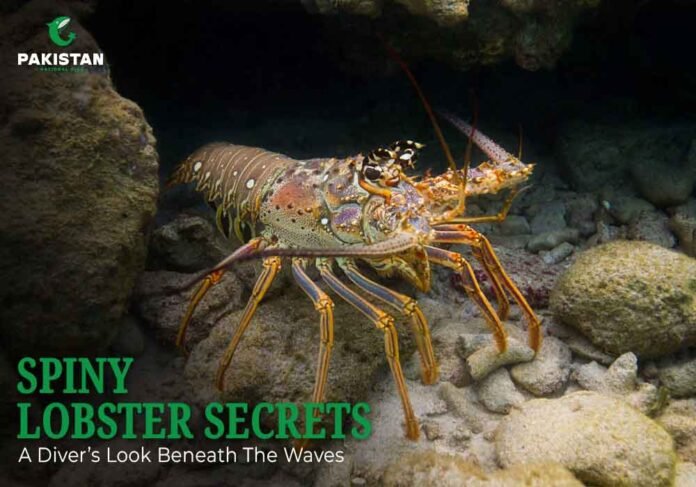The first time I came across a California spiny lobster, I wasn’t sitting at a dinner table, I was twenty feet underwater, lungs tight with held breath, mask fogging at the corners. Off Catalina Island, the rocky reef was alive with flickers of fish and swaying kelp when I spotted a reddish figure creeping from a crack. At first I thought it was a crab, until it extended two antennae so long they seemed to stretch like radar beams. Right there, I knew I had met a creature that was more than a meal, it was a mystery.
That dive became the start of a fascination I’ve never quite shaken. The more I learned, the more I realized lobsters aren’t a single story but a family of characters. Some carry heavy claws built to crush. Others, like the “spiny lobsters”, rely on armor, speed, and sharp antennae. What follows is a closer look at what makes them so remarkable from their place in the ocean’s food chain to the reason they’re prized on the grill.
Spiny Lobster at a Glance
Aspect | Details |
Scientific Name | Panulirus species (P. interruptus in California) |
Habitat | Rocky reefs, warm and temperate seas |
Average Size | Up to 24 inches; typically 2–5 pounds |
Lifespan | 15–50 years |
Unique Trait | No claws—tail meat is the prize |
Fun Fact | They “creak” with their antennae to scare predators |
Not Just One Kind of Lobster
When you say “lobster,” most people picture the massive-clawed giants stacked in tanks from Maine to Boston. But that’s just one member of a wider crustacean family. They are lined as:
- Clawed Lobsters: The American lobster (true lobster) is having its dominance in New England waters, its familiarity is for its claws which are giant. Its cousin, the European lobster (Homarus gammarus), has a bluish tint before cooking and a touch of sweetness.
- Spiny Lobsters: These clawless types favor warmer seas. The California spiny, the Caribbean spiny, and the Australian spiny are the best-known.
- Reef Lobsters: Small, brilliantly colored, and notoriously shy, they slip between coral crevices.
- Slipper & Squat Lobsters: Odd relatives that look halfway between crabs and lobsters, with flattened shells and curious habits.
An exciting fact about it is, when storms stir the seabed, spiny lobsters often line up in single file, antenna to tail, forming a kind of underwater conga line. This parade isn’t for fun; it increases their odds of survival by nearly a third.
Why California’s Spiny Lobster Is Special
The California spiny lobster (Panulirus interruptus) is more than a seafood delicacy, it’s woven into the culture of the Pacific coast. From Baja California up to Monterey, rocky reefs and kelp forests are their favor points, sometimes they hide themselves at the depths of over 200 feet.
What sets them apart are those unmistakable antennae. They’re not only delicate sensors for vibration in the water but also deterrents. A curious predator or diver, who gets too close risks a painful jab.
Size can be impressive: up to two feet long, though the average catch runs closer to twelve inches. Their flavor is another distinction: firm, slightly nutty meat that holds up beautifully on a grill.
Each year, these lobsters shed their armor to grow, a process called molting. For a limited time frame, their bodies are soft and exposed, so they move back into fissures or clefts. This natural cycle is regulated strictly limit and explain what will be their particular time of harvesting. Without those protections, populations would decline quickly.
Meet The Wider Family
Spiny lobsters belong to the Palinuridae family, which includes around sixty species spread through warm oceans worldwide. They’re classified as “achelates,” meaning “without claws.” Instead of big pincers, they use speed, spines, and sound to survive.Some lobsters are noted for:
- rock spiny lobster: They are popular for their large-scale migrations.
- Painted spiny lobster (Panulirus versicolor): A brilliantly colored species, often kept in aquariums.
- Green spiny lobster (Panulirus gracilis): Found along Pacific Central America.
Their raspy “creak” comes from rubbing the base of their antennae against shell ridges. Think of it as nature’s burglar alarm.
How Long Can They Live?
If untouched, a spiny lobster can live for decades, anywhere from 15 to 50 years. Some in protected waters off California have been recorded at more than 40 years old.
Unlike fish or trees, lobsters don’t show age through rings or lines. Since they molt their shells, researchers use tagging and long-term tracking to estimate ages. In heavily fished areas, many spiny lobsters don’t live past seven years, cut short not by predators but by traps and spears. That’s why marine reserves matter, they let some lobsters live out their natural lifespans.
Sorting Out The Names:
Lobster Type | Scientific Name | Defining Feature |
American Lobster | Homarus americanus | Heavy claws |
European Lobster | Homarus gammarus | Blue tint before cooking |
California Spiny | Panulirus interruptus | Long whip-like antennae |
Caribbean Spiny | Panulirus argus | Famous mass migrations |
Cooking Without Ruining the Catch
If you’ve ever toughened lobster meat, you know the heartbreak of overcooking. Luckily, spiny lobster is forgiving if you respect the basics:
- Chill first – Place the lobster on ice for a humane dispatch.
- Prep cleanly – Twist off the head, split the shell neatly.
- Keep it simple – Butter, garlic, and lemon are classics that don’t overpower.
- Mind the clock – Grill flesh-side down for a smoky edge, or boil no more than 8–10 minutes per pound.
- Serve hot – Once cooled, lobster loses its tenderness.
I once watched a friend proudly toss his catch into boiling water, only to leave it too long. The result? Rubber. Timing really is everything.
Why So Pricey?
Spiny lobster’s steep price tag comes down to effort and demand.
- Harvesting is tough: They hide in rocky crevices, often collected by divers.
- Reduced output: If they have no claws then their meat is lesser than others.
- High planetary demand: It is highly demanded in Asian markets.
- Strict seasons: Short, regulated seasons limit supply.
Pound for pound, they cost more than clawed lobsters, but many seafood lovers insist the tail’s firm sweetness justifies it.
Which Lobster Tastes Better?
Quick Fire FAQs
Closing Thoughts
Spiny lobsters are reminders of nature’s creativity. They communicate without voices, march together in storm-driven parades, and can outlive most pets if left alone.
Every time I dive and spot one tucked into a rocky nook, I’m transported back to that first encounter off Catalina. They’re not only a seafood but they have their stories in their shell and antennae. They are at their survivor point.


